Pride month has 30 days, so let’s talk about 30 queer artists that challenged the heteronorms of their times! These artists explored sexuality and gender identity, capturing their own queer experiences in visual media.
1. Albrecht Dürer
Albrecht Dürer was a German painter and printmaker in the late 15th and early 16th century. It’s tough to say for sure whether anyone from that long ago was queer or not, but the evidence for Dürer is pretty strong. He famously depicted a men’s bath house with nude male figures in various poses. Historians say the figure to the left is the artist and collectively the men represent the five senses. The rooster on top of the tap is considered a bit of “suggestive humor”. Other interpretations read more flirtatious and erotic undertones to the piece.

Dürer was also friends with a man named Willibald Pirckheimer. If you read that Prickheimer the first time, it’s okay – so did I. Rumor had it that the two were lovers – and Dürer’s writings suggest the same. In a letter to Pirckheimer he stated his interest in both German girls and soldiers. He also captioned a portrait of Pirckheimer that roughly translates to “With the cock in your asshole”.
2. Rosa Bonheur
Considered the most famous female painter of 19th century France, Rosa Bonheur was openly lesbian. She lived with her partner Nathalie Micas for over 40 years, and later with fellow painter Anna Elizabeth Klumpke. Bonheur outright rejected the cultural norms of the time, wearing men’s clothes and refusing to marry. She painted subjects typically seen in the work of her male counterparts – large, detailed animals in their natural (and often dirty) environments. Women’s equality was important to her and she fought for it throughout her life.

3. Harriet Hosmer
Harriet Hosmer was known as the first professional female sculptor. There must have been others before her, but she was a distinguished Neoclassical sculptor in 19th century America with many accolades. She also pioneered new processes in her field, including a method of turning limestone into marble and using wax over rough plaster to carve fine details. Recognizing the limitations a career in America would place on her, she emigrated to Rome where she could grow more freely as an artist. She openly had relationships with women, including a 25 year relationship with Lady Ashburton, a widowed Scottish noblewoman. Bonheur called Ashburton her “sposa”, while in return Ashburton called her “hubbie”.

4. Romaine Brooks
Born Beatrice Romaine Goddard, Romaine Brooks was an American painter born to a wealthy American family. Sadly she was abused as a child, so she left for Europe to make her own way as artist. Her career began in the late 1800s, but it wasn’t until the early 1900s that she developed her muted color palette of black, white, and gray with subtle pops of color.

After years of living as a poor art student, Brooks inherited the family fortune upon her mother’s passing. Money gave her the freedom to live her life as she pleased, often traveling to Rome and other parts of Europe. She spent part of her time in Paris with other “well-to-do” lesbians – dressing in men’s clothes to express her identity and painting portraits of other women that challenged conventional norms of the time.
5. Marsden Hartley
Marsden Hartley was an American printmaker and painter in the early 20th century. He was in photographer Alfred Stieglitz’s orbit along with artists like Georgia O’Keeffe and Charles Demuth. Stieglitz gave him the money to begin his travels around Europe, where he met artists like Kandinsky and Franz Marc. During his time in Germany he fell in love with a Prussian officer, who he represented in much of his work. When the soldier died in WWI, Hartley was devastated and memorialized him in Portrait of a German Officer.

Hartley’s use of German iconography was conspicuous, but the fact that he was a German sympathizer overshadowed the homoerotic undertones of his work. He denied that any gay context existed at the time and abandoned German motifs as his career progressed. Toward the end of life he created both landscapes and homoerotic paintings of men. Even though Hartley wasn’t openly gay, some of his late work – like Christ Held by Half Naked Men – make his perspective as a closeted queer artist clear.
6. Marie Laurencin
Remember when we talked about Marie Laurencin before? In her early work she expressed her own brand of ethereal cubism where she painted intimate, erotic moments between women. As her style developed and she came into her own as an artist, she was a sought-after portrait painter. Male patrons paid twice as much for a commission as women and brunettes paid more than blondes.

She married twice, but openly had affairs with both men and women. She continued to paint her ethereal women, contrasting voyeuristic work from fellow artists like Picasso with strong female subjects in control of the viewer’s gaze.
7. Charles Demuth
Charles Demuth was an American watercolorist and, later in his career, oil painter. He was friends with Marsden Hartley who introduced him to Alfred Stieglitz who brought him into the same circle as Georgia O’Keeffe and Charles Sheeler. Demuth, O’Keeffe, and Sheeler were major contributors to the Precisionist movement, which focused on industrialization and modernization depicted by strong, linear compositions and geometric forms.

In stark contrast to his Precisionist work were his erotic paintings of men and depictions of his exploits in the bath houses he frequented. These watercolor paintings were not intended for public viewing, but they give us an intimate look at what was a taboo lifestyle at the time.
8. Jean Cocteau
Jean Maurice Eugène Clément Cocteau had a lot of names, but he was also a surrealist filmmaker that self-identified as a poet. He was a novelist, playwright, artist, and critic who contributed to the avant-garde and Dadaist movements as well. Cocteau was a prominent figure among Parisian creative circles in the early 20th century and experimented with a variety of media as he collaborated with the likes of Picasso and Guillame Apollinaire.

Some might know Cocteau best for his films, but he also explored fantasy and eroticism with his drawings. He illustrated a book he anonymously published titled Le Livre Blanc. While that work is on the milder side, Cocteau openly created pieces that were far more graphic. He never hid his sexual preferences and used his talents to invite the viewer into his experience.
9. Claude Cahun
Claude Cahun was a gender-fluid self-portraitist who explored her identity through various personas. Throughout her career she dressed as sailors, dolls, aviators, body builders, puppets, and vampires. Cahun used mirrors, collage, and duplication to express the ways she rejected cultural norms and the vulnerability she experienced by being openly “other”.
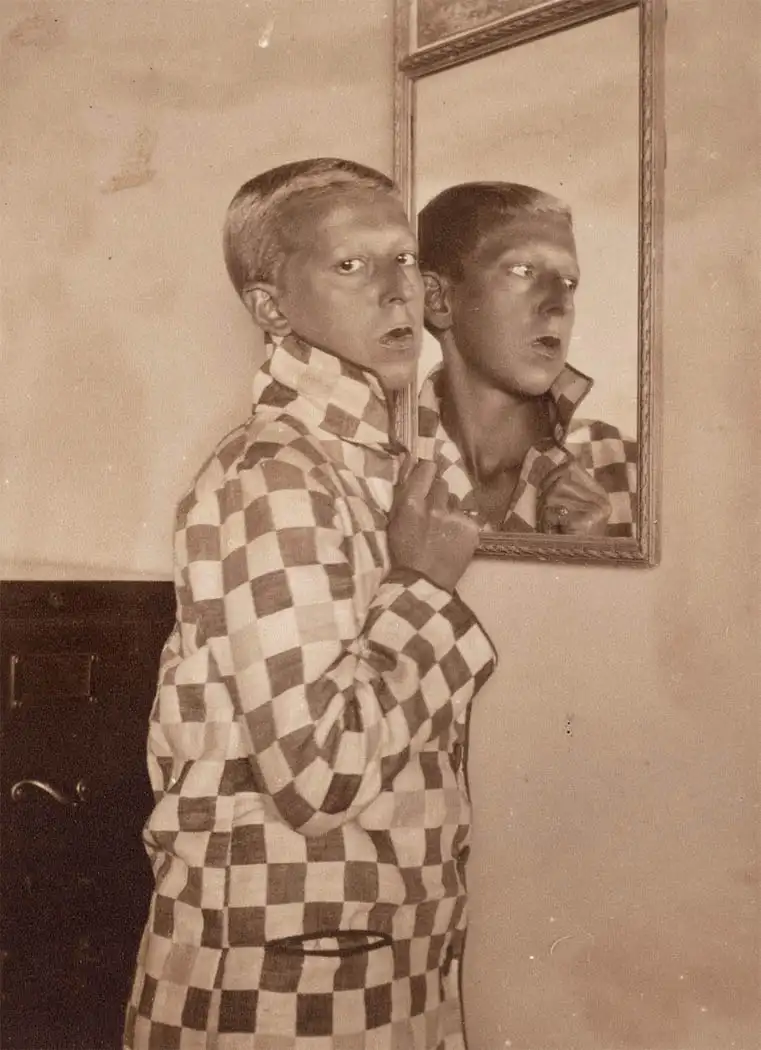
Cahun, along with her partner Marcel Moore, were also hardcore anti-German activists in the 1930s and 1940s. Leading up to the war they produced anti-Nazi fliers, dressed up as German soldiers, and distributed their literature by leaving it on chairs, sneaking it into pockets, and throwing it into cars and open windows. They were eventually caught and sentenced to death, but never saw their sentence carried out. Cahun’s work continues to inspire as it is rediscovered and reinterpreted from generation to generation.
10. Tamara deLempicka
Tamara deLempicka was known as the “Baroness with a Brush” and lived her life with all the flair you’d expect from a woman with that title. She was best known for her Art Deco style portraits – representations that exuded strength, elegance, and extravagance. What you’ll notice when you look through her work is the difference in how she portrayed men and women. Male portraits tended to be dark and somber. But the women were sensual, wrapped in bright jewel tones.

DeLempicka married men, but openly had affairs with women. She did nothing to hide to her activities and even welcomed the attention any scandalous rumors brought her way. She used her art to both explore her own identity as a queer artist and to portray women with power and control over their own sexuality.
11. Beauford Delaney
Beauford Delaney was a modernist painter who was a major presence in the Harlem Renaissance. He arrived in New York in 1929, both feeling the weight of Great Depression and inspiration from the diverse community that came together to survive on so little. Delaney’s work captured moments of struggle and humanity that not only reflect the impact of the Great Depression, but the pervasive oppression of minorities.
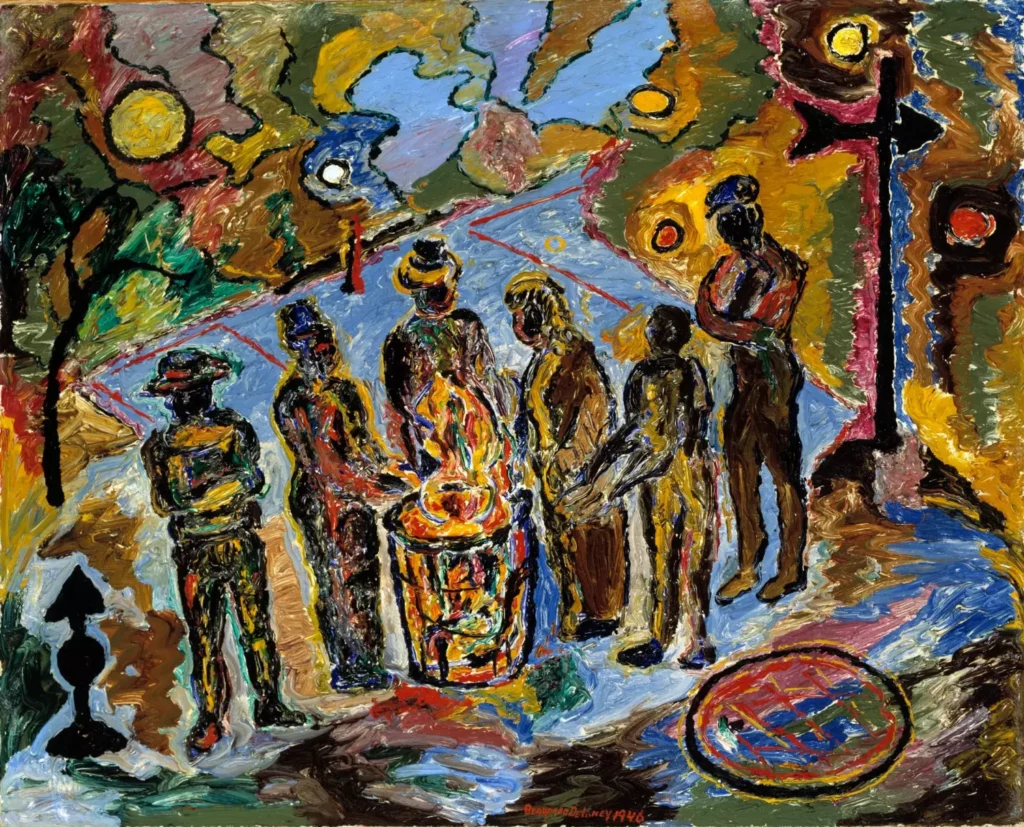
Delaney held an ideal of love and equality, but the inherent racism and homophobia that surrounded him – including among his colleagues in the art scene – led him to live a very private and isolated life. He struggled with mental illness, but continued to paint into the 1970s. His later work included colorful portraits, many featuring his favorite color yellow.
12. Paul Cadmus
Paul Cadmus was another queer artist from the early 20th century that found more acceptance in Paris. He travelled with his lover Jared French who encouraged him to dedicate his life to art. However, it wasn’t until the mid-1930s that his career really took off – all because he offended the Navy. His 1934 piece The Fleets In!, painted for the Public Works of Art Project (PWAP), featured drunken sailors in tight pants with bulging crotches carousing with women (and each other!).

Of course the Navy didn’t like their sailors to be portrayed this way, so they censored the painting for decades. Ironically it’s now part of the collection of the Naval History and Heritage Command. The controversy with the Navy brought a lot of publicity for Cadmus and he later pointed out that if they hadn’t made such a big deal about it, the general public wouldn’t have known about the painting in the first place. More importantly, Cadmus’ work documented the gay social scene of the 1920s and 1930s in New York, a time when most people had to hide their queerness to survive.
13. Frida Kahlo
Frida Kahlo was a woman that was unapologetically herself. She began painting after being severely injured in a car accident, and this was after already being disabled by polio. Kahlo often painted self-portraits because of how often she was alone and she felt it was the subject she knew best. They featured representations of her disabilities such as her broken back and the steel corset she had to wear in The Broken Column.
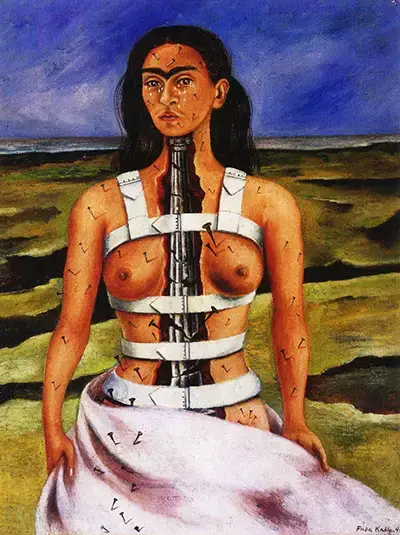
Kahlo created this piece later in her career. The tears and the nails reflected her pain and hopelessness as her health deteriorated. She continued to paint and participated in political activism until her death in 1954. Even though she died at a relatively young age, she made enough of a historical impact to make her instantly recognizable to nearly anyone.
14. Francis Bacon
We’re not talking about the 16th century philosopher (though he was probably gay, too), but the 20th century artist that shocked and captivated viewers. Francis Bacon became a painter after seeing Picasso’s work and didn’t receive a traditional arts education. His figurative work was typically dark and tortured. When explaining his compositions, he tended to sound ambivalent about some of his choices. When explaining why he painted the crucifixion he said, “because it was an armature on which I could hang certain sensations.”

Sometimes it’s hard to tell whether one of Bacon’s figures is a person or animal or just meat. They are twisted, sometimes gruesome representations. When his work gained popularity in the postwar period, it was how far he deviated from the norm that set him apart – both in his work and his life. Coming from a difficult childhood, Bacon’s art was an honest reflection of his bleak worldview, forcing the viewer to face what little separates us as humans from animals – or simply meat.
15. George Tooker
George Tooker was a figurative painter that used egg tempera paints, the medium typically used by the old masters. He was a communist, his work often exploring Marx’s theory of alienation where individuals become estranged from themselves, as well as the effects they suffered from Capitalism. On top of that Tooker was an openly gay man, adding another layer of social commentary to his paintings.

His 1956 painting Government Bureau uses repetition and detailed homogeneity to portray the tedium of bureaucracy. The background recedes into an unseen endlessness, adding to the unsettling isolation of each anonymous individual in this shared experience. The workers peeping through their windows imply a similar circumstance from the other side of the glass, but everyone in the composition is trapped by these mundane and oppressive systems all the same.
16. Andy Warhol
When you think of a Campbell’s soup can, are you actually thinking about Campbell’s soup or are you thinking about Andy Warhol? He was at the forefront of the pop art movement in the 1960s, leaving a legacy of colorful, iconic images (not to mention films, music, and print media!). But like many artists, he faced rejection early in his career.
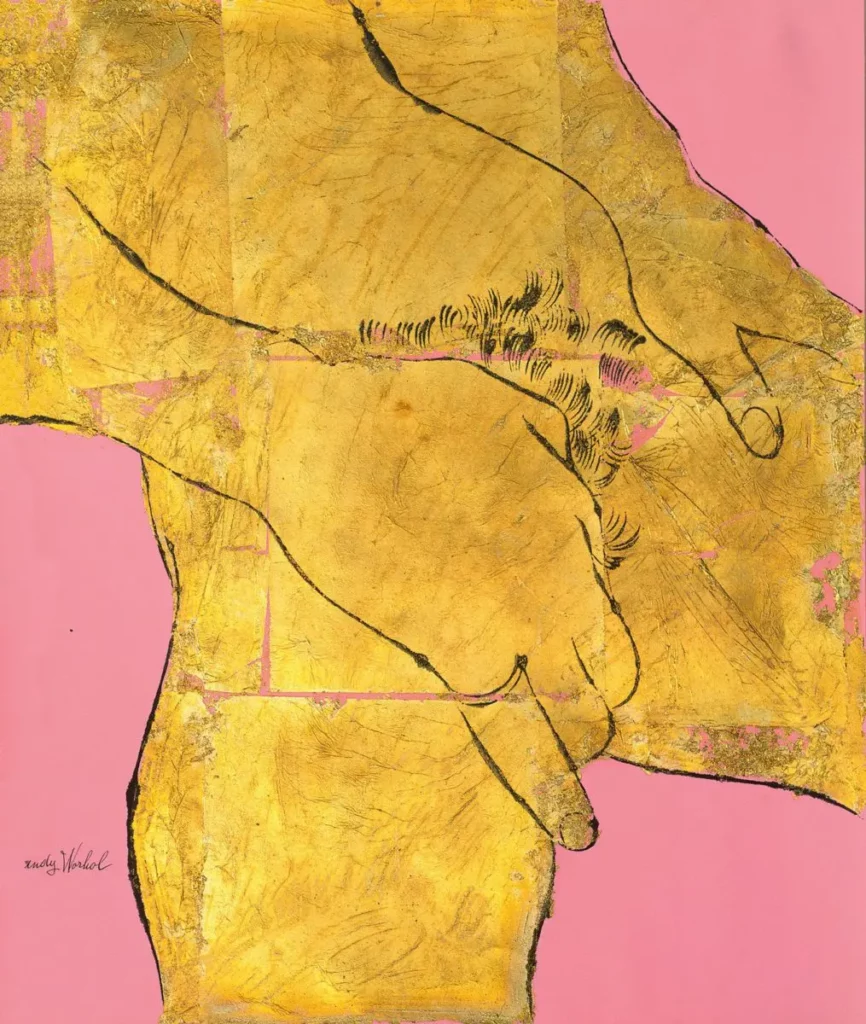
Warhol started out as a commercial artist and created personal work in his free time, but he didn’t start with soup cans and celebrities. His early work was a series of homoerotic drawings that were outright rejected by the mainstream art community because they thought it was too gay. Some of the drawings were eventually published in a book where the editor notes that Warhol was “…obsessively capturing people and moments as he would later do with his Polaroid and 35mm cameras…”. However, the drawings exuded an intimacy and sexuality that was absent in his popular work.
17. Jasper Johns
Jasper Johns turned 93 last month! He is a celebrated painter, sculptor, and printmaker that became well-known for his use of the American flag in his work. It seems an ironic choice given that he was a queer artist in the 1950s. This was a time when the gay community was being actively suppressed. The media even portrayed it as a national security risk alongside communism.
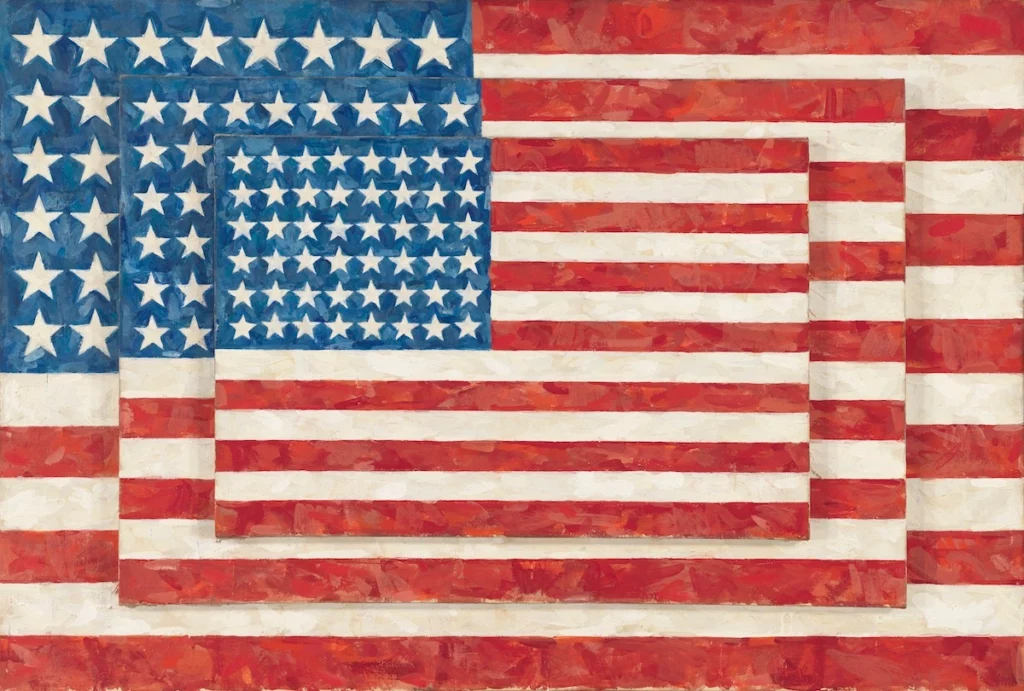
Johns became lovers with fellow artist and mentor Robert Rauschenberg. They shared something that most queer artists of the time didn’t have – a support system. They had each to share their experiences and experiment with their art. The relationship reflects deeply in their art through the use of a secret code using common objects and inside jokes.
18. David Hockney
Next month David Hockney turns 86! We worked as a pop artist in the 1960s and 70s, moving between his native London, Paris, and Los Angeles. Throughout his decades-long career he experimented with almost every 2D media you could think of – even digital! But out of all the media and subjects he explored, he always returned to portraits.

Hockney drew inspiration from people he knew or admired. It was his print media in particular through which he expressed his identity as a gay man, layered with references to pop culture and literature. His piece titled “Alka Seltzer” is based on a story he read about a cross-dresser, with a reference to an idol he had a crush on. It also features an actual Alka-Seltzer label, alluding to overindulgence.
19. Robert Mapplethorpe
Robert Mapplethorpe was a bad boy photographer who helped make photography the art form that it’s considered today. He is best known for his utilitarian black and white compositions whose subjects ranged from portraits to flowers to nudes to leather. He preferred to photograph nude black men, a preference that led critics to accuse him of creating exploitative work.
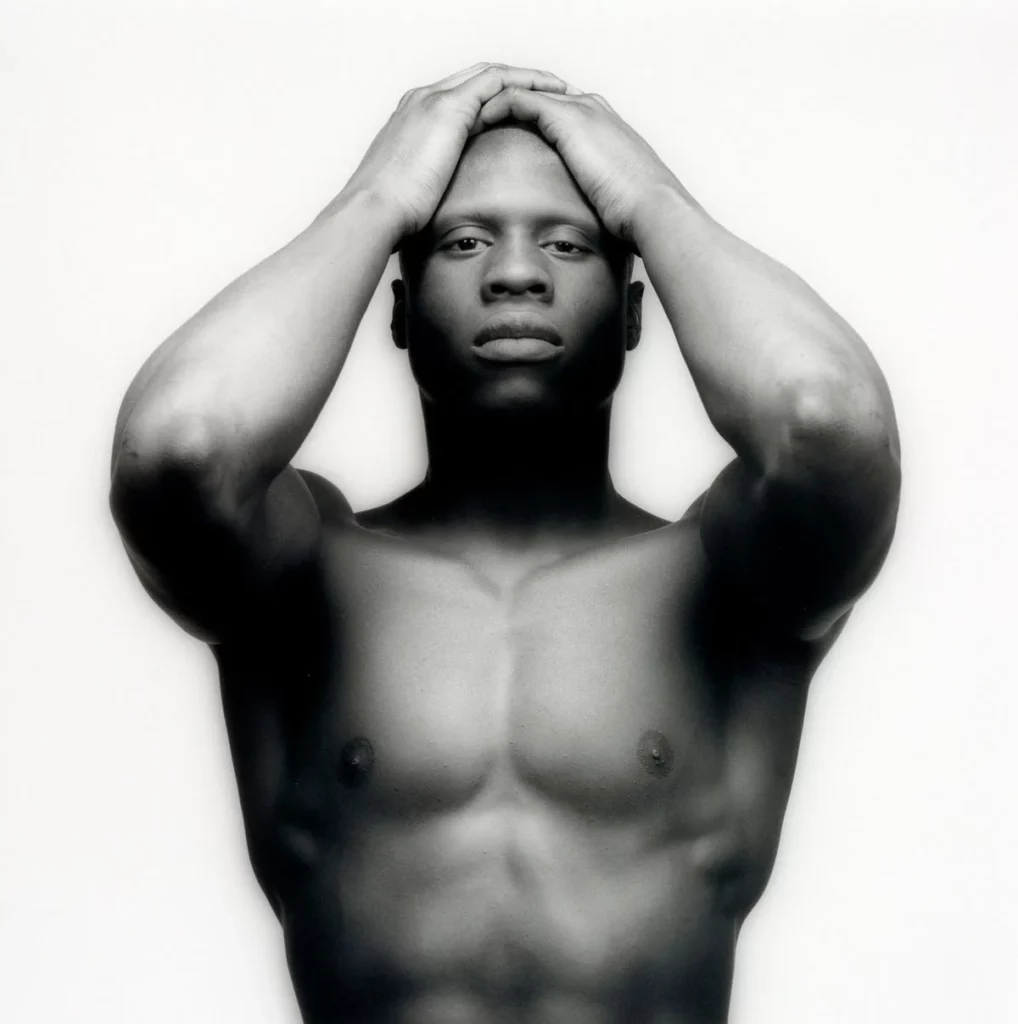
Mapplethorpe’s work was also criticized as being borderline pornographic, which wasn’t far off. He explored the BDSM subculture of 1970s New York – frequently participated in the scenes he captured after he played the role of voyeur as the photographer.
20. Annie Leibovitz
Some of the most iconic celebrity photos to feature on magazine covers were taken by Annie Leibovitz. She worked for major magazines like Rolling Stone, Vanity Fair, and Vogue. Her career has put her in front of scores of major celebrities and it’s even alleged that she insulted the Queen of England because she asked to remove her tiara for the photo.

Leibovitz’s career began in the 1970s and she is still working. She continues to take stunning portraits and work in advertising, while galleries and museums feature retrospectives of her work.
21. Felix Gonzales-Torres
Imagine being able to walk into a gallery, look at the art, and physically take a piece of that art home with you. Felix Gonzales-Torres created that exact experience with his work. In some of installations he used common objects in stacks or piles – like a huge pile of candy in a corner or a stack of copy paper.

Each candy pile was unique and weighed a specific total amount – sometimes representing a specific person. The viewer, who was integral to the art itself, was always allowed to take a piece of candy. Whether or not the candy was replenished varied by installation and was never known by the viewer. This stood for the spread of ideas and allowed the experience of his art to go beyond the elitist atmosphere of the traditional gallery.
22. Keith Haring
Whether you know it or not, you’ve seen Keith Haring’s work. Art was a part of his life from a young age, but it was his New York City subway graffiti that started getting the public’s attention. He found the swaths of empty space the perfect place to experiment. This is where his “Radiant Baby” was born, which he used to sign his work. Beyond the colorful dancing figures, Haring celebrated gay culture with strong homoerotic imagery, covering the walls of galleries with scenes sex, love, and desire.

Before he died, Haring started the Keith Haring Foundation to provide education to disadvantaged youth and educate the public about HIV and AIDS. His legacy lives on both through his foundation and his strong footing in pop culture. His work is not only eye-catching and relatable, but a lasting representation of the queer community.
23. Laura Aguilar
Laura Aguilar devoted her career to representing marginalized groups, particularly queer ChicanX and LatinX communities and the diversity within. She was a Mexican-American photographer who understood first-hand the inherent discrimination that came with being a full-bodied, Hispanic lesbian. Aguilar used intimate self-portraits to celebrate her body and challenge conventional ideals of beauty.
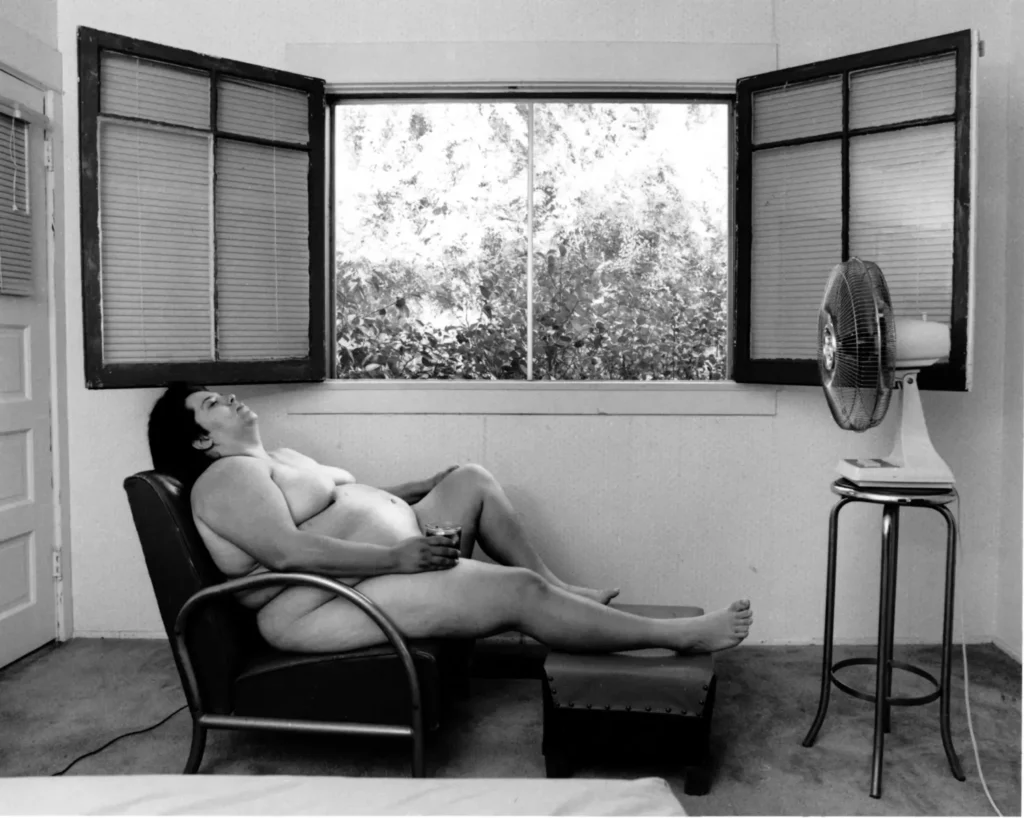
Aguilar’s work also explored the disadvantages people suffer as a result of their sexuality, race, and/or class. She showed how any label of “other” applied by mainstream society can harm individuals and communities by restricting access to opportunity.
24. Glenn Ligon
Glenn Ligon uses “text paintings” to challenge the societal constructs of race, sexuality, and gender. In the early 1990s he began painting quotes from Black authors, using black text on a white background that got progressively darker until it was illegible. The dichotomy of exposing the text to the viewer and making it difficult to read bring into question the effectiveness of the words themselves. Ligon used the same technique in conjunction with images to explore Black masculinity and the oppression of gay Black men.

Ligon explored many ways to obscure text, using media like oil sticks and coal dust. In some of his compositions, the text could only be discerned by the texture.
25. Catherine Opie
Armed with a Kodak Instamatic camera, Catherine Opie began her journey as a photographer at nine years old. Taking pictures of her family as a child evolved into a photography career that documents queer experiences from across the community. She isn’t afraid to push boundaries or explore the more alternative facets of queer culture. Opie has literally bled for her art.

Opie recently retired from teaching at UCLA, but continues to work out of Los Angeles. She travels the country, focusing on various groups and subcultures, documenting their place in the American landscape.
26. Kehinde Wiley
If you saw the 2018 portrait of Barack Obama, you’ve seen the work of Kehinde Wiley. He’s known for painting naturalistic portraits of Black people. Throughout his career Wiley has referenced works of the old masters, fusing their compositions with his modern style to blur the boundaries between styles and time periods.

Wiley also uses this juxtaposition to explore racial inequality. He took it a step further in his series An Archaeology of Silence. He painted the figures of people who suffered senseless deaths in compositions that referenced scenes of mythological heroes and saints.
27. Salman Toor
Salman Toor is a Pakistani-born American artist. He paints figurative scenes describing his experience as a gay man that is marginalized because of his race and his sexuality. His compositions contrast scenes of love, acceptance, and comfort with those of violence and discrimination in both public and private spaces. He explores the differences in those experiences between brown men and those of other ethnicities.
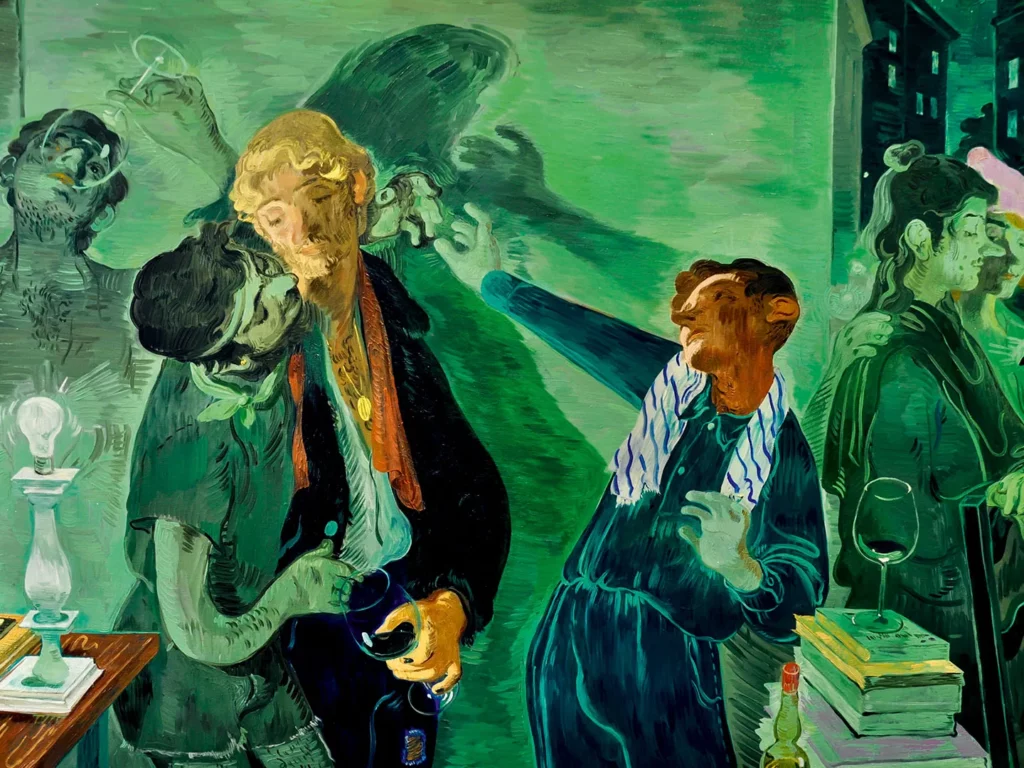
Toor paints his men to be “sissies”. He uses the beauty of his sissies to challenge what it means to be a man, how a man should look, and how a man should behave. “The way people consume masculinity—I’m trying to kick it out of its complacency.”
28. Fabián Cháirez
Fabián Cháirez is a Mexican painter whose work challenges masculine ideals by depicting queer men in traditional Mexican roles. He is known for taking famous figures and eroticizing them, with one of his works infamously causing a protest.

It was Cháirez’s portrait of Emiliano Zapato that upset the late revolutionary’s descendants and 200 protestors. Rather than the traditional portrayal of a rugged hero, Cháirez rendered Zapato’s lithe naked body atop an aroused horse. As he continues to push the boundaries of gender norms in his work, Cháirez hopes to foster tolerance and acceptance of the LGBTQIA+ community.
29. Chloe Filani
Chloe Filani is an artist, writer, performer, and poet using her voice and body to convey her experience as a Black trans woman. She describes her process as a spark in the beginning, often happening in the earliest hours of the morning – one that she must capture in the moment before she loses it. Sometimes she will edit her work, other times she lets it be.

“I couldn’t find stories of trans and gender-variant people in that culture but I know that culture would have had a different way of existing [in terms of gender]. Many Yoruba names are not gendered – Femi, Tolu, Toyin, for example – and it feels that there was an erasure of them and their stories. To imagine the past also allows me to imagine the future.”
30. Yaz Metcalfe
Yaz Metcalfe uses art to describe their experience as a trans disabled creator. It serves as both a means to cope with existing in an inaccessible world and to support people that have also been treated as outsiders simply because they are different.
Metcalfe draws inspiration from other disabled artists like Frida Kahlo and Bob Flanagan and carries on a message of perseverance and inclusivity. “It excites me that I too am able to create that same magic. Art comes out of my body like a release of energy, and every time it heals me: my alternative medicine”
